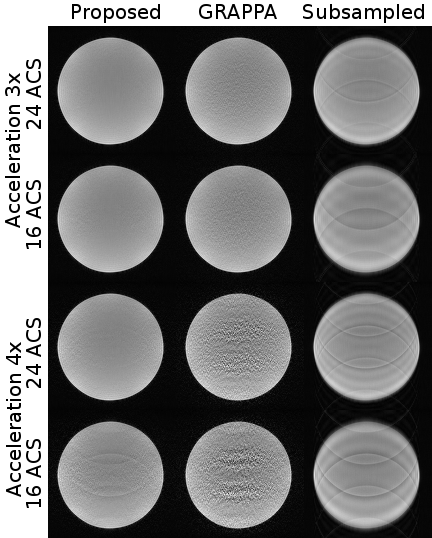New GRAPPA MRI recontruction method published

A new methodology for reconstruction of subsampled multi-coil MRI data has been published in the International Journal of Computer Assisted Radiology and Surgery: "Improving GRAPPA reconstruction by frequency discrimination in the ACS lines".
Purpose: GRAPPA is a well-known parallel imaging method that recovers the MR magnitude image from aliasing by using a weighted interpolation of the data in k-space. To estimate the optimal reconstruction weights, GRAPPA uses a band along the center of the k-space where the signal is sampled at the Nyquist rate, the so-called Autocalibrated (ACS) lines. However, while the subsampled lines usually belong to the medium-high frequency areas of the spectrum, the ACS lines include the low frequency areas around the DC component. The use for estimation and reconstruction of areas of the k-space with very different features may negatively affect the final reconstruction quality. We propose a simple, yet powerful method to eliminate reconstruction artifacts, based on the discrimination of the low frequency spectrum.
Methods: The proposal to improve the estimation of the weights lays on a proper
selection of the coefficients within the ACS lines, which advises discarding those points around the DC component. A simple approach is the elimination of a square window in the center of the k-space, although more developed approaches can be used.
Results: The method is tested using real multiple-coil MRI acquisitions. We empirically show this approach achieves great enhancement rates, while keeping the same complexity of the original GRAPPA and reducing the g-factor. The reconstruction is even more accurate when combined with other reconstruction methods. Improvement rates of 35% are achieved for 32 ACS and acceleration rate of 3.
Conclusions: The method proposed highly improves the accuracy of the GRAPPA coefficients and therefore the final image reconstruction. The method is fully compatible with the original GRAPPA formulation and with other optimization methods proposed in literature, and it can be easily implemented into the commercial scanning software.
